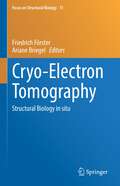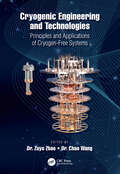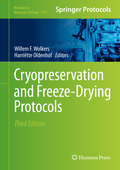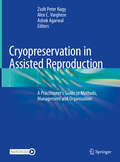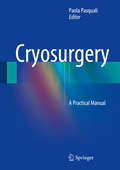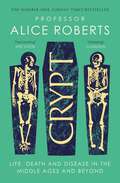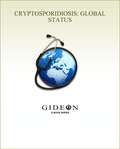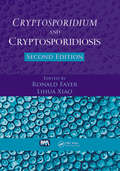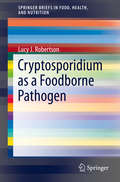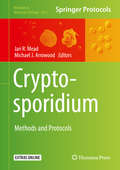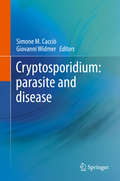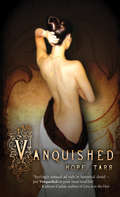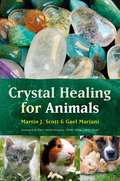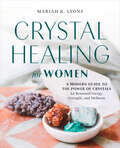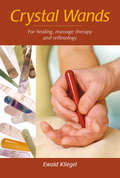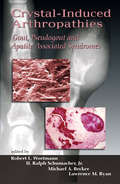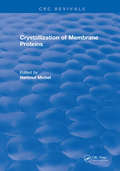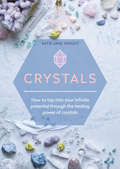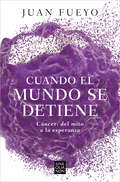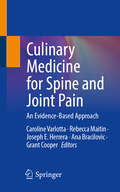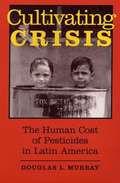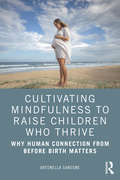- Table View
- List View
Cryo-Electron Tomography: Structural Biology in situ (Focus on Structural Biology #11)
by Friedrich Förster Ariane BriegelThis book presents key aspects and recent developments of cryogenic sample electron tomography (cryo-ET) methodology, authored by leading experts in the field. Understanding structure and function of biomolecules in the context of cells is a new frontier in cellular and structural biology. To facilitate such research, cryo-ET is a key method to visualize the molecules of life in their native settings. Cryo-ET enables the imaging of samples that are preserved in a near-native state, at (macro)-molecular resolution and in three dimensions. Thus, this technique is a unique tool to gain insights into how biomolecules collaborate in orchestrating fundamental biological processes, how mutations cause diseases, pathogens cause infections, and to develop novel therapeutics to treat such illnesses. This book provides a unique reference for the emerging field of cryo-ET. The topics covered range from the fundamental principles of imaging to sample preparation, data analysis,and data sharing within the scientific community. It serves as a valuable resource for the next generation of structural biologists, making it suitable both for undergraduate students studying biochemistry, biophysics, and molecular biology and highly valuable for the more experienced and specialized PhD student. Furthermore, it stands as a state-of-the–art source of knowledge for the established senior scientist within the field of structural biology.
Cryogenic Engineering and Technologies: Principles and Applications of Cryogen-Free Systems
by Dr Chao WangCryogen-free cryogenics is leading a revolution in research and industry by its significant advantages over traditional liquid helium systems. This is the first overview for the field, covering the key technologies, conceptual design, fabrication, operation, performance, and applications of these systems. The contents cover important topics such as the operating principles of 4K cryocoolers, enabling technologies (including vibration reduction) for cryogen free systems, the cryogen- free superconducting magnet, and cryogen-free systems that reach mK. It highlights the wide range of applications in materials science, quantum physics, astronomy and space science, medical sciences and etc. Key features: Introduce technologies and practical know-how employed for cryogen-free systems of using 4 K cryocoolers to replace liquid helium; Address state of the arts of cryogen-free superconducting magnets, sub-kelvin refrigeration systems of He-3 sorption cooler, adiabatic demagnetization refrigerator (ADR) and dilution refrigerators (DR). Discuss applications of cryogen-free systems in modern instruments and equipment.
Cryopreservation and Freeze-Drying Protocols, 3rd Edition (Methods in Molecular Biology #1257)
by Willem F. Wolkers Harriëtte OldenhofThis volume provides a variety of standard protocols used to cryopreserve or freeze-dry different types of specimens. In addition, it provides chapters focused on the fundamental principles of cryopreservation, vitrification, and freeze-drying. Several state of the art microscopic, spectroscopic as well as calorimetric methods are highlighted that can be used to study cellular and macromolecular changes in response to freezing or drying. Written in the highly successful Methods in Molecular Biology series format, chapters include introductions to their respective topics, lists of the necessary materials and reagents, step-by-step, readily reproducible laboratory protocols, and tips on troubleshooting and avoiding known pitfalls. <P><P> Authoritative and practical, Cryopreservation and Freeze-Drying Protocols, Third Edition serves as a practical guideline for studies on freezing and drying processes as well as preservation strategies for biological specimens.
Cryopreservation in Assisted Reproduction: A Practitioner's Guide to Methods, Management and Organization
by Ashok Agarwal Alex C. Varghese Zsolt Peter NagyCryopreservation of oocytes, sperm, and ovarian and testicular tissues, as well as embryos, is one of the most critical procedures to preserve the reproductive capacity of individuals. It is an indispensable part of assisted reproductive technologies, as nearly all IVF clinics around the world have embraced the freeze-all embryo strategy with no fresh embryo transfers. Advanced platforms, such as automation and artificial intelligence, are making their way into all aspects of assisted reproductive technologies, including reproductive tissue banking process and storage. At the same time, lax regulations and lack of training combined with rapid demands of IVF services have resulted in a climate of frequent disaster and catastrophic incidents from the cryo labs that store thousands of patients’ embryos for years. With the onset of malpractice lawsuits against the clinics and awards of large compensation to the patients, regulations are getting stricter in this arena to safeguard the integrity of storage systems, and industry leaders are developing advanced devices and alarm systems to remotely monitor storage systems exploring the power of internet, AI and automation. Therefore, there is an urgent need for a comprehensive text in this field based on the introduction of such a wide array of advanced devices, newer technologies, regulatory frameworks, risks and disaster management options. With contributions from top internationally recognized scientists and clinicians with expertise in cryopreservation and reproductive technology, this book provides a comprehensive overview of the basics of cryobiological processes and a technically detailed presentation on all aspects of cryopreservation of reproductive cells and tissues. It presents the current, well-established procedures, as well as novel techniques with the latest innovations described in detail. Bringing together the latest information with key thought leaders in the field, Cryopreservation in Assisted Reproduction is intended to be the go-to resource for all reproductive medicine clinicians, embryologists, lab technologists, IVF lab directors/managers, and researchers.
Cryosurgery: A Practical Manual
by Paola PasqualiThis book aims to fill the gap created by the lack of formal training in cryosurgery, which leads not only to an underutilization of the technique but also to inappropriate uses with unpleasant consequences for patients. The book covers all practical aspects of cryosurgery and also offers a theoretical foundation for practice. Basic principles, equipment, and techniques are described, and procedures are explained step by step for a range of applications, including common benign lesions, vascular lesions, premalignant conditions, and malignancies. An important feature is the coverage of the latest advances in combination treatments such as topical drugs and cryosurgery, ultrasound and cryosurgery, photography and cryosurgery, cryobiopsy, and immuno cryosurgery. Use of cryosurgery as palliative treatment is also discussed, and the closing chapters consider postoperative care, complications, and future directions.
Crypt: Life, Death and Disease in the Middle Ages and Beyond
by Alice RobertsTHE SUNDAY TIMES NO. 1 BESTSELLERCHOSEN BY WATERSTONES AS ONE OF THEIR BEST HISTORY BOOKS OF 2024 'Compulsive . . . A wonderful display of how modern archaeology can bring hidden histories to life' Daily Telegraph 'Gripping . . . I found it hard to put down' Evening Standard 'Another really good book from archaeologist Alice Roberts . . . Helps you understand the facts on a technical level, but also makes you feel them in your bones' New Scientist 'Robert's reflections on Thomas Becket and Canterbury Cathedral are especially entertaining . . . Fascinating' Spectator The new book by Sunday Times bestselling author of Ancestors and Buried - the final instalment in Professor Alice Roberts' acclaimed trilogy.We can unlock secrets from bones preserved for centuries in tombs, graves and crypts. The history of the Middle Ages is typically the story of the rich and powerful, there&’s barely a written note for most people&’s lives. Archaeology represents another way of interrogating our history. By using cutting-edge science to examine human remains and burials, it is possible to unearth details about how individuals lived and died that give us a new understanding of the past – one that is more intimate and inclusive than ever before. The seven stories in Crypt are not comforting tales. We meet the patients at one of the earliest hospitals in England and the victims of the St Brice&’s Day Massacre. We see a society struggling to make sense of disease, disability and death, as incurable epidemics sweep through medieval Europe. We learn of a protracted battle between Church and State that led to the murder of Thomas Becket and the destruction of the most famous tomb in England. And we come face to face with the archers who went down with Henry VIII&’s favourite ship, the Mary Rose. Beautifully written and expertly researched by Professor Alice Roberts, Crypt is packed with thrilling discoveries that will make you see the history of Britain afresh.
Cryptosporidiosis: Global Status 2010 edition
by Dr Stephen Berger Gideon InformaticsCryptosporidiosis: Global Status is one in a series of GIDEON ebooks which summarize the status of individual infectious diseases, in every country of the world. Data are based on the GIDEON database (www.gideononline.com) which relies on standard text books, peer-review journals, Health Ministry reports and ProMED, supplemented by an ongoing search of the medical literature. Chapters are arranged alphabetically, by country name. Each section is divided into five subsections. 1. Descriptive epidemiology 2. Summary of clinical features 3. Global status of the disease 4. Status of the disease in a specific country 5. References
Cryptosporidium and Cryptosporidiosis
by Lihua Xiao Ronald FayerFrom the microscopic observation of infection to the widespread application of molecular techniques in taxonomy and epidemiology, to the genome sequencing of two major species and advances in biochemistry, phylogeny, and water treatment, new information on this fascinating genus continues to mount as we discover and utilize the latest scientific te
Cryptosporidium as a Foodborne Pathogen (SpringerBriefs in Food, Health, and Nutrition)
by Lucy J. RobertsonAlthough widely recognized as an important waterborne pathogen, Cryptosporidium spp. can also be transmitted by contamination of food. The same properties of this protozoan parasite that mean that water is an excellent transmission vehicle are also important for foodborne transmission. These include the low infective dose, the high number of oocysts that are excreted, and the robustness of these transmission stages. However, many more outbreaks of waterborne cryptosporidiosis have been reported than foodborne outbreaks. This is probably partly due to epidemiological tracing being much more difficult for foodborne outbreaks than waterborne outbreaks, and the number of persons exposed to infection often being fewer. Nevertheless, the potential importance of foodborne transmission is gradually being recognized, and a wide range of different foodstuffs have been associated with those outbreaks that have been recorded. Additionally, various factors mean that the potential for foodborne transmission is becoming of increasing importance: these include the growth of international food trade, a current trend for eating raw or very lightly cooked foods, and the rise in small-scale organic farms, where there the possibility for contamination of vegetable crops with animal feces may be greater.
Cryptosporidium: Methods and Protocols (Methods in Molecular Biology #2052)
by Jan R. Mead Michael J. ArrowoodThis book encompasses broad aspects of Cryptosporidium research with established methods that have been improved and expanded over the years as well as recent cutting-edge techniques. Within this collection are numerous molecular methods as well as protocols for genotyping and diagnostics, while also including room for in vitro cell culture techniques to address the issues with growing this difficult organism continuously. Written for the highly successful Methods in Molecular Biology series, chapters include introductions to their respective topics, lists of the necessary materials and reagents, step-by-step, readily reproducible laboratory protocols, and tips on troubleshooting and avoiding known pitfalls. Authoritative and practical, Cryptosporidium: Methods and Protocols serves as an idea guide to the inherent challenges of working with cryptosporidial parasites to provide a foundation for new investigators to build upon.
Cryptosporidium: Parasite And Disease
by Simone M. Cacciò Giovanni WidmerThis new volume on Cryptosporidium and Cryptosporidiosis discusses all relevant aspects of the biology, molecular biology, host-parasite interaction, epidemiology as well as diagnosis and treatment of these widespread parasites. It represents a useful guide for physicians, microbiologists, veterinarians and water professionals seeking advanced knowledge and guidance about these important parasitic pathogens. A section on practical lab procedures discusses step-by-step guidelines for sample preparation and lab procedures. The new book may further serve as a reference work for graduate students in medical and veterinary microbiology.
Crystal Balance: A Step-by-Step Guide to Beauty and Health Through Crystal Massage
by Michael Gienger Monika Grundmann Ines BlerschMany approaches to crystal massage focus on relaxation techniques for both body and mind, but only the method introduced in this practical step-by-step guide is designed to achieve inner and outer beauty. This method, known as Crystal Balance, maintains that physical well-being reflects upon every aspect of our everyday lives as well as our inner selves, and so massage can be effective on every level of the body, mind, and soul. As the method can utilize a wide variety of crystals, all of which have different healing properties, it can be personalized from patient to patient. The guidebook features clear descriptions of the gemstones used in the therapy, from agate to zoisite, and their properties, as well as a variety of exercises and goals to promote body relaxation and recovery.
Crystal Healing for Animals
by Scott Martin Gael MarianiDiscover how the healing power of crystals can be used to enhance the wellbeing and happiness of the animals in your careTake a guided tour of thirty of the most commonly used and effective healing crystal and gemstones, showing how you can easily and inexpensively build up a collection that will last a life time and go on providing healing support to your animal friends as the years go by. Animal problems covered include: abuse and trauma, allergies, bereavement and grief, hyperactivity, constipation, inflammation, low immunity, muscle strains and pains, post-surgical recovery, stress, training problems and animal/human relationships, and much more. This book also contains special sections on training and animal rescue, showing the role that crystals can play in this context.Crystal healing is as effective and potent a healing art today as it was in the time of the ancient Egyptians. It is even more effective with animals than for humans, and any pet owner or animal caregiver can easily learn to master the basic techniques of choosing and cleansing crystals, dowsing and crystal massage, making crystal essences, and the use of crystal layouts in healing. Crystal Healing for Animals explains these methods in plain and simple language and will be useful for beginners and experienced crystal users alike.
Crystal Healing for Women: A Modern Guide to the Power of Crystals for Renewed Energy, Strength, and Wellness
by Mariah K. LyonsCrystal Healing for WomenA Modern Guide to the Power of Crystals for Renewed Energy, Strength, and WellnessDiscover the physical, mental, and spiritual healing power of crystals and awaken the healer within. Believed to hold restorative powers over our health, crystals have served humanity for millennia. With Crystal Healing for Women, you can unlock the ancient secrets of healing and wisdom held within these stones. Crystal healer and Reiki Master Mariah K. Lyons shares her knowledge in this beautifully-illustrated, practical guide that helps women awaken to their feminine divinity and healing powers, and rekindle their instinctual relationship with nature. She also shows you how to select and care for crystals and incorporate them in rituals. You'll learn to intentionally utilize crystals, helping you to find deeper levels of spiritual growth, integrated healing, and sustainable well-being. Crystal Healing for Women features: • Crystal healing fundamentals: How crystal vibrational energy works as well as how to activate, charge, and cleanse your crystals. • 40 energetic self-care rituals: Daily and seasonal wellness practices plus focused healing and manifestation for fertility, pregnancy, the feminine cycle, anxiety, creativity, and love. • 50 healing crystal profiles: Modern interpretations, individual features, and beautiful photographs of stones with energetic properties and healing compatibilities. • 10 key crystals for women: An in-depth look at select stones chosen for their potency, healing power, and connection to Divine Feminine energy. • Crystals in everyday life: Where to place them in your home and on your body and how to work with them and create crystal-healing grids.
Crystal-Induced Arthropathies: Gout, Pseudogout and Apatite-Associated Syndromes
by Robert L. Wortmann H. Ralph SchumacherDivided into five expansive sections, this guide provides an in-depth review of crystal-induced arthritis and related disorders. Providing a historical perspective throughout, this work includes detailed descriptions of the clinical features of these diseases, as well as a current overview of their identification, epidemiology, genetics, and underl
Crystallization of Membrane Proteins
by Hartmut MichelThe precise knowledge of the structure of biological macromolecules forms the basis of understanding their function and their mechanism of action. It also lays the foundation for rational protein and drug design. The only method to obtain this knowledge is still crystallography. At present, the structures of about 400 proteins are known at or nearly at atomic proteins. However, only two of them are membrane proteins or complexes of the membrane proteins. The reasons for the difference is not the crystals of membrane proteins resists forming special problems when being analysed. The reason is that the membrane proteins resist into forming into well-ordered crystals. The intention of this book is to help to produce well-ordered crystals proteins and to provide guidelines, it is aimed at both biochemists and protein crystallographer‘s.
Crystals: How to tap into your infinite potential through the healing power of crystals
by Katie-Jane WrightVictoria Beckham uses them backstage at her fashion shows.Miranda Kerr places them in her meditation-yoga room.Adele raves about their calming properties. Welcome to the world of healing crystals.Crystals have existed on earth for millions of years. They're a tool which work with your energy field to absorb, focus and direct energies. This modern, empowering guide illustrates how to tap in to the energy of crystals to strengthen intuition, set intention and feel supported by the beauty and energetic vibrations of popular and lesser known stones. Crystals may be used as talismans, healing touchstones, tools for meditation and accessing different levels of consciousness. Including 50 crystals and their meaning, how to get started working with the energy of crystals, crystal grids, skulls and cleansing meditations, this stunning book is the definitive, inspiring introduction to crystals for the next generation.
Crystals: How to tap into your infinite potential through the healing power of crystals
by Katie-Jane WrightVictoria Beckham uses them backstage at her fashion shows.Miranda Kerr places them in her meditation-yoga room.Adele raves about their calming properties. Welcome to the world of healing crystals.Crystals have existed on earth for millions of years. They're a tool which work with your energy field to absorb, focus and direct energies. This modern, empowering guide illustrates how to tap in to the energy of crystals to strengthen intuition, set intention and feel supported by the beauty and energetic vibrations of popular and lesser known stones. Crystals may be used as talismans, healing touchstones, tools for meditation and accessing different levels of consciousness. Including 50 crystals and their meaning, how to get started working with the energy of crystals, crystal grids, skulls and cleansing meditations, this stunning book is the definitive, inspiring introduction to crystals for the next generation.
Cuando el mundo se detiene: Cáncer del mito a la esperanza
by Juan Fueyo«Tenía que escribir este libro porque se me cayó la mordaza, porque ni los médicos ni los investigadores ni los pacientes deben callarse más. ¿Callarse por qué? Ya no. La era del silencio sobre el cáncer se acabó» El nuevo libro de Juan Fueyo es, sin duda, su obra más esperada: «el libro de mi vida», en sus propias palabras, «el más fácil y, a la vez, el más difícil de escribir», explica el autor. Cuando el mundo se detiene, fruto de más de veinticinco años de investigación en los campos de la medicina, la neurología y la investigación oncológica, ofrece una visión personal, vívida y sorprendente de una enfermedad que es una de las principales causas de muerte en todo el mundo, y que todavía no ha dejado de ser un enigma. El autor presenta un análisis multifocal y multidisciplinario de las diferentes facetas médicas, biológicas, culturales, históricas y sociales del cáncer. La enfermedad se explica desde enfoques históricos y socioculturales: sus principales causas, los últimos avances en el diagnóstico, así como los tratamientos más avanzados, proyectando una visión holística del paciente como miembro de una sociedad un poco más libre de los estigmas del pasado.
Culinary Medicine for Spine and Joint Pain: An Evidence-Based Approach
by Grant Cooper Joseph E. Herrera Ana Bracilovic Caroline Varlotta Rebecca MaitinCulinary Medicine is a field of growing interest and importance. Medical doctors are increasingly aware that they have not received adequate training in this field in medical school, residency or fellowship, and patients frequently ask their doctors about appropriate diets for spine and joint conditions. Doctors are often left to &“google&” the question, shrug their shoulders, or send the patients to nutritionists who don&’t have specific training on culinary medicine for spine and joint issues. This unique book provides evidence-based clarity on the questions of what food choices are appropriate for promoting and maintaining a healthy musculoskeletal system. The book opens with the essentials of Culinary Medicine, an overview of the anti-inflammatory diet, and the importance of the gut microbiome to overall health and well-being. Subsequent chapters discuss its application to a variety of spine and joint conditions, including degenerative disc disease, spinal stenosis, osteoarthritis, tendinopathies, muscle growth and aerobic workout. Practical pearls are the provided for how to incorporate Culinary Medicine into one's practice.
Cultivating Compassion: How Digital Storytelling Is Transforming Healthcare
by Pip Hardy Tony SumnerThis book explores how digital storytelling can catalyze change in healthcare. Edited by the co-founders of the award-winning Patient Voices Programme, the authors discuss various applications for this technique; from using digital storytelling as a reflective process, to the use of digital stories in augmenting quantitative data. Through six main sections this second edition covers areas including healthcare education, patient engagement, quality improvement and the use of digital storytelling research. The chapters illuminate how digital storytelling can lead to greater humanity, understanding and, ultimately, compassion. This collection will appeal to those involved in delivering, managing or receiving healthcare and healthcare education and research, as well as people interested in digital storytelling and participatory media.
Cultivating Crisis: The Human Cost of Pesticides in Latin America
by Murray Douglas L.In this study, Douglas Murray draws on ten years of field research to tell the stories of international development strategies, pesticide problems, and agrarian change in Latin America. Interwoven with his considerations of economic and geopolitical dimensions are the human consequences for individual farmers and rural communities.
Cultivating Mindfulness to Raise Children Who Thrive: Why Human Connection from Before Birth Matters
by Antonella SansoneCultivating Mindfulness to Raise Children Who Thrive introduces an expanded view of human development and health, which begins before conception and moves through pregnancy, early childhood and adulthood. This book is a call for all prenatal and perinatal professionals and policy makers to appreciate indigenous ways of knowing, being and doing and integrate them with scientific evidence in the care of expectant parents and their babies. It explains how this could also tackle pressing social issues facing the modern world and favour social innovations through a revaluation of preconception, pregnancy, birth and childcare practices. Sansone presents the reader with scientific discoveries of epigenetics, interpersonal neuroscience, quantum physics, attachment, anthropology, prenatal and perinatal psychology and mindfulness, which interestingly resonate with the intuitions of primal wisdom. The book will be of interest to clinicians, policy makers, researchers, parents, and those interested in the prenatal and perinatal roots of human development and well-being.
Cultivating Your Microbiome: Ayurvedic and Chinese Practices for a Healthy Gut and a Clear Mind
by Bridgette SheaA holistic guide to improving your gut flora for better physical and emotional health • Explores the influence of the gut microbiome and the mesentery on all other bodily systems, especially the brain and immune system • Explains the central role of the digestive system in Ayurveda and traditional Chinese medicine and how these systems treat the microbiome • Presents herbal remedies, acupuncture and acupressure techniques, and dietary methods to restore balance to your gut flora, including a microbiome reset In traditional medicine, such as Indian Ayurveda and Chinese medicine, the digestive system and microbiome are recognized as the foundation for good health. Our internal flora influences our immune system, brain function, hormonal balance, cravings, sleep, mood, inflammatory response, digestion, nutrient assimilation, and elimination. In this holistic guide to cultivating a healthy microbiome and managing gut health naturally, Bridgette Shea explores digestive functioning from the perspectives of both Western science and traditional medicine. She examines Ayurvedic and Chinese medicine principles on digestion and constitution types. She reveals how, in addition to describing what we now call the microbiome, traditional Chinese medicine also has long recognized the importance of an abdominal organ that modern science has only recently acknowledged: the mesentery, the tissues that connect and support the internal organs. Going beyond probiotics and prebiotics, the author presents practices from Ayurveda and Chinese medicine to reestablish balance in your internal microbiome, support the mesentery, improve digestion and elimination, and restore a clear mind and strong immune system. She explains how to read your symptoms, from brain fog and fatigue to congestion and stool quality, and offers herbal remedies, acupuncture and acupressure techniques, and dietary methods to improve your internal health, including a microbiome dietary reset. Revealing the diverse role that our inner microbial colonies play in keeping us happy and healthy, this book shows that by changing your microbiome, you can greatly improve your physical, emotional, and mental health.
